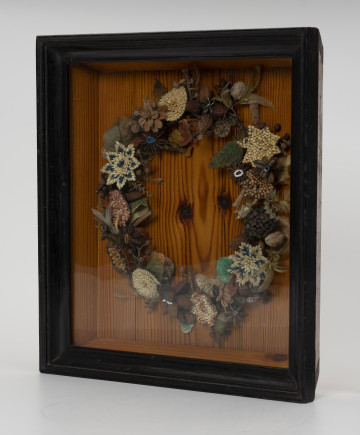
Souvenir wreath in a glass frame
1890 — 1910
National Museum in Szczecin
Part of the collection: Independent twenty years of the Second Polish Republic
The gorget, known since the Middle Ages, was the lower part of a knight's helmet until the mid-15th century, covering the collarbone and part of the torso. With the disappearance of armour, it functioned as a separate piece, reducing in size and losing its protective importance, and in the 18th century the metal flange was abandoned and it began to be hung on a chain. However, it remained as a form of military badges. During the reign of King Augustus III (1696–1763), Polish officers wore uniform gorgets with an Eagle, and Lithuanians with Pogonia. Some particularly religious military groups placed Marian images on their gorgets, similarly to earlier images of this type found on cuirasses. Over time, the gorget became more patriotic and religious in character, which is why around 1790, for political reasons, it ceased to be the official badge of the Polish army, returning only in the period of the Polish Legions and the Duchy of Warsaw, and gaining particular popularity in the interwar period. In post-war Poland, it completely disappeared from the army, although its devotional importance has remained to this day. The image of the Virgin Mary from the gorget is modelled on a 17th-century painting from the Chapel of Our Lady of the Gate of Dawn in Vilnius. The veneration of this image became popular thanks to the invocation written by Adam Mickiewicz (1798–1855). At that time, the Holy Mother of Vilnius became not only the heroine of numerous literary works, but also the patroness of Polish exiles. The creator of the presented gorget is Victor Gontarczyk (1882–1948), a graduate of the Warsaw Fr. Konarski School of Artistic Crafts and a participant in the drawing courses of Wojciech Gerson. He engaged in artistic craftsmanship, specializing in coloured metals, creating in particular military badges, medals and gorgets. Paula Sendra
Author / creator
Object type
ornament, keepsake
Technique
casting, bending
Material
bronze, metal, copper
Origin / acquisition method
donation
Creation time / dating
Owner
Muzeum Narodowe w Szczecinie
Identification number
Location / status

1890 — 1910
National Museum in Szczecin

1890 — 1910
National Museum in Szczecin

1910
National Museum in Szczecin
DISCOVER this TOPIC
National Museum in Lublin
DISCOVER this PATH
Educational path